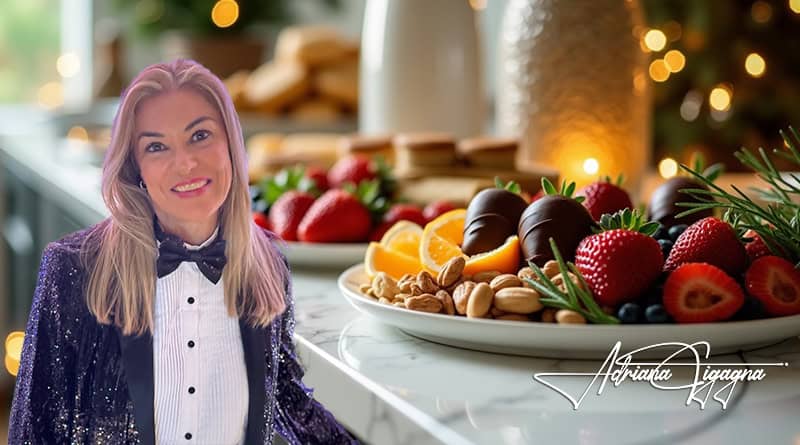Quick and Easy: Healthy Holiday Eating Tips to Escape Temptation
Did you know the average person gains 1-2 pounds during the holiday season? While that might not sound like much, research shows people rarely shed this weight after the holidays.
Picture this – you’re at a holiday buffet, surrounded by cookies, cakes, and comfort foods. The internal battle begins as you try to make healthy choices while fighting temptation. Like many others, I’ve faced this challenge and understand how overwhelming it can feel.
Here’s the good news: enjoying the holidays and maintaining healthy eating habits aren’t mutually exclusive. The right healthy holiday eating tips will help you enjoy seasonal festivities without guilt or restriction.
You might want to prevent holiday weight gain or feel more confident around seasonal treats. We’ve got your back. This piece offers practical strategies that help you make mindful choices while savoring your favorite holiday foods.
Ready to reshape your holiday eating experience? Let’s get started!
Table of Contents
ToggleCreate Your Holiday Eating Game Plan
A solid game plan helps you succeed with healthy holiday eating. Here’s how we can build one that fits your lifestyle.
Setting Clear Nutrition Goals
Your success with holiday eating depends on realistic goals. Rather than trying strict diets, you should focus on maintaining your weight during the holidays. Regular meal schedules are a vital part – you tend to overeat later when you skip meals. Our main goal should be to stick to normal eating patterns while leaving room to enjoy special holiday treats.
Identifying Trigger Foods and Situations
Everything in healthy habits starts with knowing your food triggers. Holiday triggers that come off the top of my head include:
- Social events with easy access to food
- Special holiday treats you can’t get other times
- Eating due to holiday planning stress
- Holiday drinks packed with calories
You need to position yourself away from these trigger foods at events. The best strategy is to keep your distance from buffet tables at social gatherings so you don’t eat mindlessly.
Building a Support System
No one succeeds alone. Share your healthy eating goals with friends or family members you trust – they are a great way to get encouragement. Holiday meals feel much better when someone who understands your food needs is there with you.
Your regular meal schedule matters – try to eat every 4-5 hours to keep your energy steady. This routine helps you avoid the “save up calories” mindset that guides you to overeat at holiday events.
This thoughtful game plan sets you up for success while you enjoy the festive season. You don’t need to be perfect – just find a balanced approach that works for you.
Master the Pre-Party Strategy
Let’s become skilled at preparing for holiday parties. Experience shows that good preparation helps us maintain healthy eating habits during celebrations.
Smart Pre-Event Meal Planning
My clients learn quickly that skipping meals before a party leads to overindulging. Regular meals throughout the day work best. Your pre-party meal should be 3-4 hours before the event to allow proper digestion. Fill half your plate with colorful fruits and vegetables.
Healthy Snack Arsenal
A ready supply of healthy snacks is significant to avoid feeling famished at parties. Here’s what my pre-party snack collection includes:
- Greek yogurt with fresh fruit
- Whole grain crackers with hummus
- Colorful vegetable sticks with light dip
- Small handful of nuts and dried fruit
Strategic Hydration Schedule
Hydration plays a vital role in managing hunger and energy levels. Your body needs at least eight glasses of water daily. This hydration timeline works well:
- Start the morning with a full glass of water
- Drink water consistently throughout the day
- Have an extra glass an hour before the event
Alternating between water and holiday beverages during the party helps you stay hydrated while managing calorie intake. The one-to-one rule works best with alcoholic drinks: one glass of water for every festive drink.
These pre-party strategies set you up for a great time at holiday gatherings. You can feel fantastic throughout the season and still enjoy all the festivities.
Navigate Social Events Like a Pro
The party has started, and it’s time to put our preparation to work. I’ve found that holiday eating success comes down to three simple strategies that let us enjoy celebrations while staying true to our health goals.
The Plate-Building Formula
At the buffet table, I use what I call the “colorful plate strategy.” Here’s my proven formula to build a balanced plate:
- Fill half the plate with non-starchy vegetables and fruits
- Quarter of the plate with lean protein
- Remaining quarter with complex carbohydrates or holiday favorites
Note that using a smaller plate can naturally help control portions.
Conversation Positioning Techniques
Your standing spot matters just as much as your food choices. Standing away from the buffet table during conversations makes a big difference. This simple change prevents mindless snacking while you chat. My focus stays on meaningful conversations, which studies show can help slow down our eating pace.
Graceful Food Declining Scripts
Turning down food offers doesn’t need to feel uncomfortable. The “compliment-then-decline” approach works well. Start with genuine appreciation: “That looks amazing – you’re such a thoughtful host” followed by a gentle decline: “I’m trying to stick to my health plan today”. With persistent offers, staying positive while being firm helps: “Thank you so much for thinking of me, but I’m feeling great with what I’ve had”.
Note that mindful eating during holidays isn’t about restrictions. It’s about making conscious choices that help us feel our best. Balanced portions, smart positioning, and graceful communication let us maintain healthy eating goals while enjoying holiday celebrations fully.
Design Your Home Environment for Success
Your home environment is a vital part of keeping healthy eating habits during the holidays. I found that there was a way to make healthy choices almost automatic by setting up our kitchen with purpose.
Kitchen Organization Makeover
A well-laid-out kitchen forms the base of healthy holiday eating. You should remove expired items and foods that don’t match your wellness goals. Here’s my tested organization system:
- Place healthy snacks at eye level
- Store trigger foods in hard-to-reach places
- Use clear containers for visibility
- Keep fresh fruits in plain sight
Healthy Food Placement Strategy
Food placement affects our choices by a lot. Research shows that visible fresh fruit on the kitchen counter makes us more likely to choose it as a snack. My fridge’s eye-level space always contains pre-cut vegetables and healthy proteins. This simple approach helps us make better choices when hunger hits.
Managing Food Gifts and Leftovers
Holiday seasons bring food gifts that might not match our health goals. People who live with others should work together to find different storage spots for tempting treats. The two-hour rule is vital for leftovers: all perishable items need refrigeration within two hours of cooking. Small, shallow containers ensure quick cooling.
Note that creating a supportive home environment helps make healthy choices easier rather than restricting you. A thoughtfully arranged kitchen lets us stick to wellness goals while enjoying the holiday season.
Conclusion
Healthy holiday eating celebrates seasonal joy while making mindful choices that help us feel our best. Smart planning, pre-party strategies, and thoughtful social navigation help us maintain our wellness goals during the festive season.
Success comes from creating the right environment at home and social gatherings. Small changes like strategic food placement, mindful plate building, and graceful communication make the most important difference in our holiday eating habits.
Note that perfect eating isn’t our goal – we need to find balance between enjoying holiday traditions and maintaining healthy habits. These practical strategies will help you approach holiday gatherings confidently with tools that serve your health and happiness.
Holiday eating tips work best with consistent practice. Start using them today and see how they revolutionize your relationship with food this festive season.
FAQs
Q1. How can I maintain a healthy diet during the holiday season? Focus on maintaining your regular meal schedule, fill half your plate with fruits and vegetables, and position yourself away from buffet tables at social gatherings. Allow yourself to enjoy special treats in moderation while prioritizing nutrient-rich foods.
Q2. What’s a good strategy for pre-holiday party eating? Eat a balanced meal 3-4 hours before the event, focusing on colorful fruits and vegetables. Keep healthy snacks like Greek yogurt with fruit or vegetable sticks with hummus on hand. Stay hydrated throughout the day and have an extra glass of water an hour before the party.
Q3. How can I politely decline food offers at holiday gatherings? Use the “compliment-then-decline” approach. Start with a genuine appreciation of the food, then gently explain that you’re trying to stick to your health plan. If pressed, remain positive but firm, thanking the host for their thoughtfulness while reaffirming your decision.
Q4. What’s the best way to organize my kitchen for healthy holiday eating? Remove expired items and foods that don’t align with your wellness goals. Place healthy snacks at eye level and store tempting foods in hard-to-reach places. Keep fresh fruits visible on the counter and pre-cut vegetables at eye level in the fridge to make healthy choices more convenient.
Q5. Is it okay to indulge in unhealthy foods during the holidays? It’s fine to enjoy special holiday treats in moderation. One day of indulgence won’t significantly impact your overall health or weight. The key is to maintain balance by making mindful choices most of the time and not abandoning healthy habits completely during the festive season.

Legal Disclaimer:
The content provided in this guide is for informational purposes only and reflects personal experiences and opinions. While every effort is made to provide accurate information, this guide does not constitute professional or medical advice.




